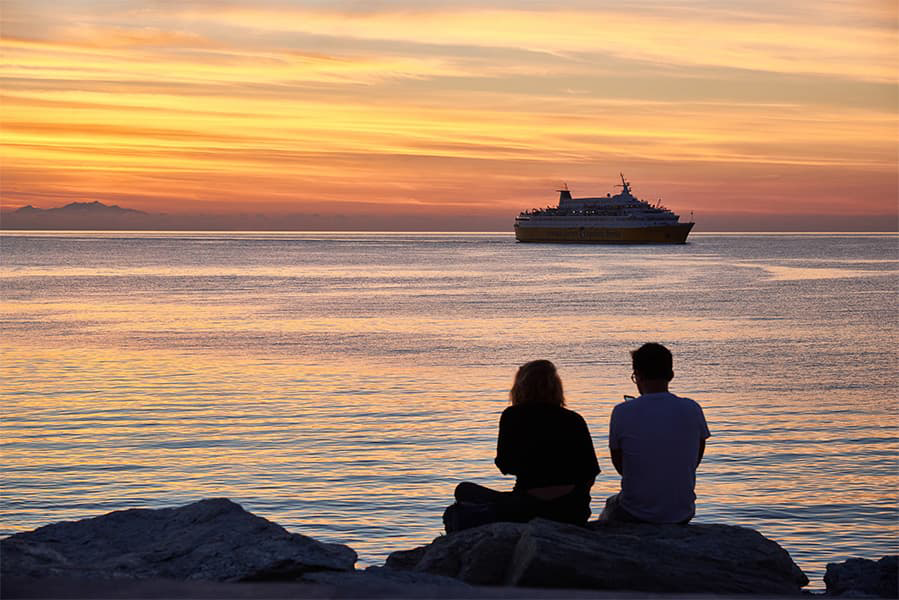Psara – Athens (Piraeus)
Ferry to Athens
Psara – Athens (Piraeus)
Ferry to Athens

There is usually one weekly sailing from Psara to Athens (Piraeus).Blue Star Ferries provides the ferry from Psara to Athens (Piraeus). Psara Athens (Piraeus) ferries take around 6 hours 55 minutes. The ferry costs between $148.13 and $149.75, depending on ticket details. Prices exclude any service fees. Ferry timetables change seasonally, use our Deal Finder to get live pricing and availability for ferries from Psara to Athens (Piraeus).
The earliest Psara Athens (Piraeus) ferry typically departs Psara at about 01:15 and the last ferry usually leaves at 13:50.
Ferries from Psara to Athens (Piraeus) sail in around 6 hours 55 minutes. The fastest ferry is approximately 6 hours 55 minutes. Ferry duration can vary by ferry provider and can be impacted by weather conditions.
There is 1 weekly sailing from Psara to Athens (Piraeus) provided by Blue Star Ferries.
The price of a ferry from Psara to Athens (Piraeus) typically range between $148.13* and $149.75*. On average the Psara Athens (Piraeus) ferry is $148.95*. The cheapest Psara Athens (Piraeus) ferry prices start from $148.13*. The average price for a foot passenger is $148.95*.
Pricing will vary depending on number of passengers, vehicle type, route and sailing times. Pricing is taken from searches over last 30 days and exclusive of service fees, last updated 1 April 2025.
The distance between Psara to Athens (Piraeus) is approximately 138 miles (222km) or 120 nautical miles.
Yes, Psara Athens (Piraeus) ferries allow cars onboard with Blue Star Ferries between Psara and Athens (Piraeus). To view car ferry tickets and prices between Psara and Athens (Piraeus) use our Deal Finder.
Blue Star Ferries allow foot passengers on Psara Athens (Piraeus) ferries.
Blue Star Ferries allow pets on ferries from Psara to Athens (Piraeus). Please also note that your pet may have to stay in the vehicle during the journey.
More routes than anyone else.

Compare fares, times & routes in one place.
Change plans easily with flexi tickets.

Book e-tickets & manage trips in-app.
Live ship tracking & real-time updates.

Top-rated customer support when you need it.
The Greek island of Psara lies in the Aegean Sea and is around 80 km to the north west of Chios and 150 km to the north east of Athens, the Greek capital. The island's landscape is characterised with hills and mountains, with Prophitis Ilias, at 640 meters above sea level, being the island's highest point. The island only has one small village which is also home to the island's harbour. Most of the island's residents work is linked to the sea, especially given that the island's interior is very mountainous and that tourism on the island is not particularly well established. However, popular sites on the island include the Archaeological Museum, the monastery of the Assumption of the Virgin Mary and its library and the Church of Aghios Nikolaos.
Psara and the East Aegean Islands in general are connected to the port of Piraeus. From Psara you can also visit the nearby Cycladic islands of Syros, Tinos, Mykonos, Andros etc.
The Greek city and port of Piraeus is one of the largest ports in the whole of the Mediterranean, and the third largest in the world, and has become a major hub for the ferry network that spans the Aegean Sea. Piraeus is an important city in its own right despite the fact that it is frequently considered to be a suburb of Athens, the Greek capital, which is only a very short distance away. Despite its proximity to Athens, Piraeus' waterfront has its own distinct appearance and visitors will see that the most appealing parts of the city are located around its eastern quarter, alongside both Mikrolimano Harbour and Zea Marina. A popular event in Piraeus is the Ecocinema International Film Festival which is held annually in late February and is where a number of films are screened at the Atticon Cinema and the Cineac Cinema, which are both located in the city's Town Hall Square.
Full of restaurants, bars and nightclubs, the waterfront district was greatly redeveloped in time for the Athens Olympics and as a result a new harbour front promenade was created that is lined with trees and passes the medieval city walls. The walls serve as a reminder and as an insight into the city's rich past.